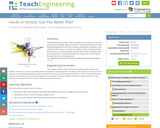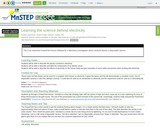
This online worksheet assesses student understanding of electric potential energy.
- Subject:
- Physics
- Science
- Material Type:
- Activity/Lab
- Provider:
- PhysicsLAB
- Author:
- Paul G. Hewitt
- Date Added:
- 02/26/2019

This online worksheet assesses student understanding of electric potential energy.

This lab demonstrates Ohm's law as students set up simple circuits each composed of a battery, lamp and resistor. Students calculate the current flowing through the circuits they create by solving linear equations. After solving for the current, I, for each set resistance value, students plot the three points on a Cartesian plane and note the line that is formed. They also see the direct correlation between the amount of current flowing through the lamp and its brightness.

In this physics lab students will investigate whether Ohm's Law applies to common electric devices (incandescent light bulbs and LEDs). Students will design a controlled experiment, including a written procedure, and then conduct the experiment, collect and graph data. Students may submit their findings in a formal written report or through informal class discussion.

This set of problems provides students practice with calculations dealing with electric circuits. Each problem features an audio clip describing the solution process. 34 problems in the set

This unit focuses on charges and electric fields. It also introduces students to voltage or potential difference. Many of the initial ideas and concepts are abstract ideas, while some incorporate the use of hands on labs and numerical equations.

Students will expand upon their previous knowledge about electromagnetic induction by investigating how transformers work. Students will work in pairs to complete a series of hands-on activities using iron cores, a battery, wire, and a galvanometer.

In this activity, students use the provided table to organize information about the average monthly time usage and energy consumption for all electrical appliances in their home. Upon collecting data and calculating costs, they draw conclusions regarding the types of appliances which are the biggest consumers of electrical energy. Teachers will need to supply the average cost of a kiloWatt-hour for the local area. Students will create a complete lab write-up at the conclusion of the activity.

Using plastic straws, wire, batteries and iron nails, student teams build and test two versions of electromagnets one with and one without an iron nail at its core. They test each magnet's ability pick up loose staples, which reveals the importance of an iron core to the magnet's strength. Students also learn about the prevalence and importance of electromagnets in their everyday lives.

In this advanced physics lesson, students will review electricity and circuitry concepts through a Power Point presentation and then dissect a disposable camera to investigate the internal circuit structure.

Students explore the composition and practical application of parallel circuitry, compared to series circuitry. Students design and build parallel circuits and investigate their characteristics, and apply Ohm's law.

Background: students are familiar with static electricity, charge, and sparks. They also know about conservation of energy, forms of energy including potential energy, power, and work. Students will complete a variety of activities using breadboards, which will display various types of circuits and their effect on the flow of electricity.

Students use potatoes to light an LED clock (or light bulb) as they learn how a battery works in a simple circuit and how chemical energy changes to electrical energy. As they learn more about electrical energy, they better understand the concepts of voltage, current and resistance.

Students use engineering design principles to construct and test a fully solar powered model car. Several options exist, though we recommend the "Junior Solar Sprint" (JSS) Car Kits that can be purchased with direction from the federal government. Using the JSS kit from Solar World, students are provided with a photovoltaic panel that produces ~3V at ~3W. An optional accessory kit also from Solar World includes wheels, axles and drive gears. A chassis must be built additionally. Balsa wood provides an excellent option though many others are available. The testing of the solar car culminates in a solar race between classmates.

Students build their own two-cell batteries. They also determine which electrolyte solution is best suited for making batteries.